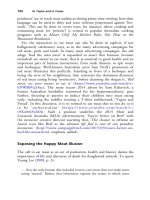The palgrave international handbook of a 228
Bạn đang xem bản rút gọn của tài liệu. Xem và tải ngay bản đầy đủ của tài liệu tại đây (37.24 KB, 1 trang )
International Trade in Animals
and Animal Parts
Jennifer Maher and Tanya Wyatt
Introduction
Societies have always consumed wildlife, making it a part of markets and trade
between people. Whereas trade of wildlife typically reflects the monetary value
attached to their instrumental worth (to people), this chapter also recognises
the intrinsic value of wildlife. Our exploration of the welfare of wildlife in trade
is thereby underpinned by green criminology, specifically a species justice
framework where wildlife have the right to live free from suffering and
harm. With that in mind, our chapter not only investigates the abuse inflicted
upon wildlife smuggled to fill the demand for illegal wildlife trade (IWT) but
also touches upon the abuse that is inherent in the legal trade as well.
The language used to discuss both the legal and illegal trade in wildlife can
reflect the instrumental nature of people’s relationship with wildlife and
where possible we try to avoid this. Consequently, we do not use some
common phrases such as ‘harvesting’ or ‘collecting’ as these commodify
wildlife rather than recognising them as individuals. Furthermore, we recognise the anthropomorphic nature of categories such as ‘wildlife’ and
‘animals’, however, for clarity and stylistic purposes, we use these terms.
J. Maher (*)
Centre for Criminology, University of South Wales, Pontypridd, United Kingdom
e-mail:
T. Wyatt
Northumbria University, Newcastle, United Kingdom
© The Author(s) 2017
J. Maher et al. (eds.), The Palgrave International Handbook of Animal
Abuse Studies, DOI 10.1057/978-1-137-43183-7_11
223









